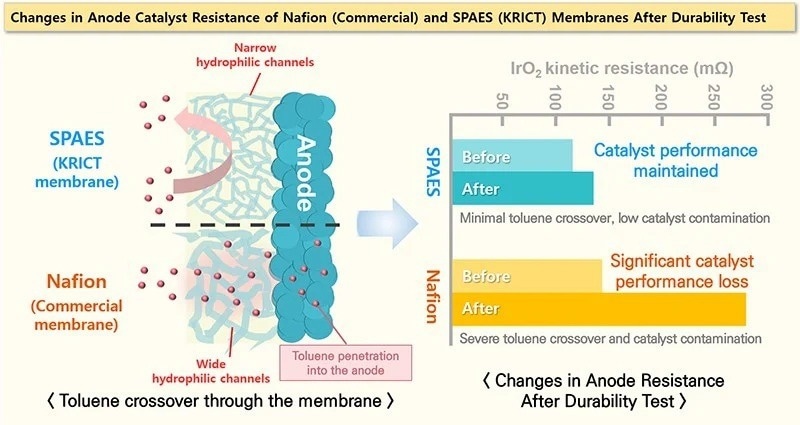Innovative Proton Exchange Membrane Boosts Electrochemical Hydrogen Storage Systems in Korea
Key Ideas
- Korean researchers develop a novel PEM based on SPAES for electrochemical hydrogen storage, improving efficiency over Nafion membranes.
- The innovative membrane reduces toluene permeability by 60% and increases Faradaic efficiency to 72.8% in hydrogenation processes.
- Through durability tests, the SPAES membrane showed a 40% reduction in voltage degradation rate compared to Nafion, with improved chemical and mechanical stability.
- The breakthrough is expected to pave the way for high-efficiency hydrogen storage systems by 2030, supporting clean energy applications like fuel cells and hydrogen power generation.
A research team in Korea, led by Dr. Soonyong So from the Korea Research Institute of Chemical Technology (KRICT) and Professor Sang-Young Lee of Yonsei University, has made a significant advancement in electrochemical hydrogen storage systems. By developing a novel proton exchange membrane (PEM) based on sulfonated poly(arylene ether sulfone) (SPAES), the team addressed key challenges in hydrogen storage technology.
The new SPAES membrane significantly outperforms the commonly used perfluorinated PEM, Nafion. It reduces toluene permeability by over 60% and increases the Faradaic efficiency of hydrogenation to 72.8%. This innovation is crucial as toluene, a liquid organic hydrogen carrier (LOHC), offers a promising alternative for hydrogen storage and transport under more manageable conditions compared to traditional methods.
The unique design of the SPAES membrane includes narrow hydrophilic channels that facilitate proton transport while restricting the diffusion of toluene molecules, effectively reducing crossover by 60%. During durability tests, the membrane exhibited a 40% lower voltage degradation rate compared to Nafion, showcasing enhanced stability over extended use.
The research team foresees that this breakthrough will contribute to the development of high-efficiency, standalone electrochemical hydrogen storage systems that could gain commercial feasibility by 2030. The advancement has positive implications for clean energy systems like hydrogen fuel cell vehicles and power generation, aligning with the global transition towards a hydrogen economy. The work, published in the Journal of Materials Chemistry A, was conducted by a collaborative team of researchers from KRICT and Yonsei University, with strong support from KRICT President Youngkook Lee.
